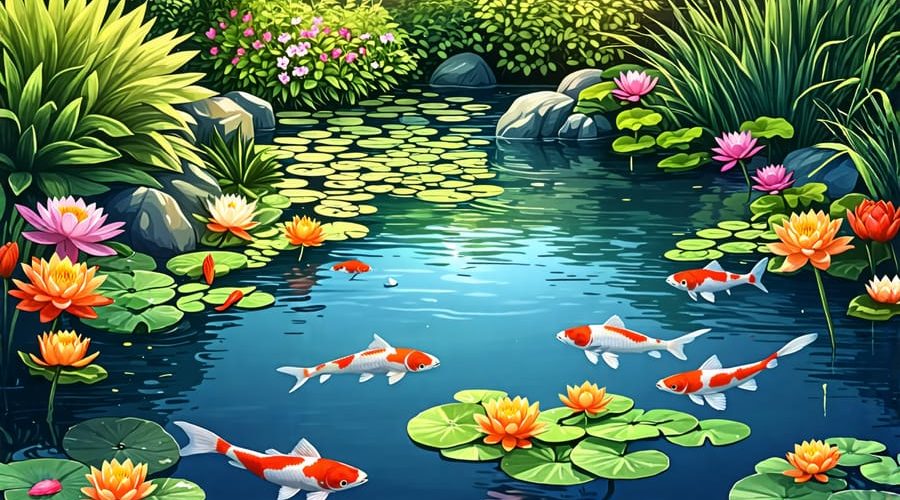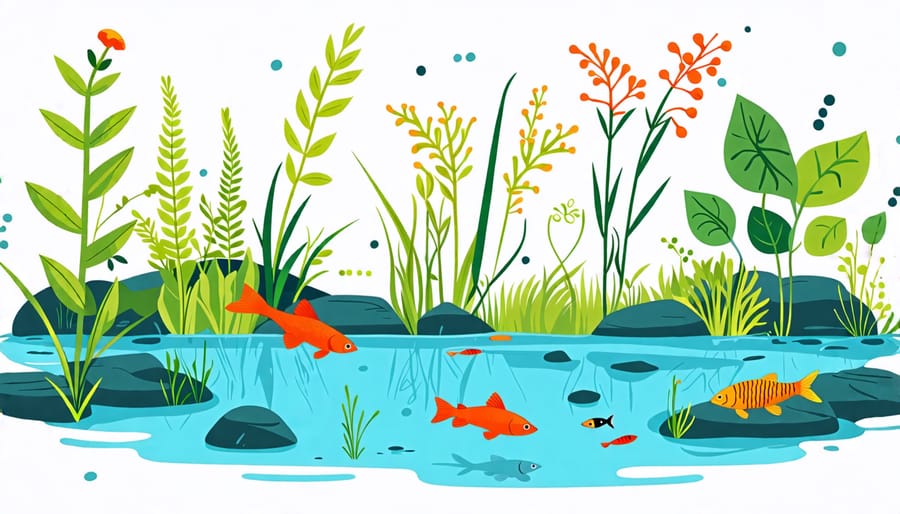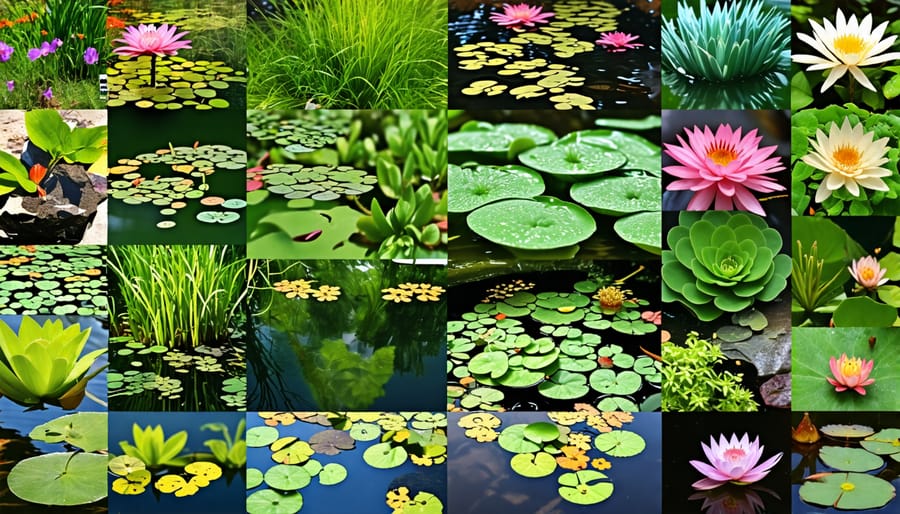
The Perfect Pond: Creating a Thriving Plant and Fish Ecosystem
Creating a thriving plant and fish ecosystem requires careful planning and balance. Selecting compatible aquatic plants and fish species is crucial for establishing a self-sustaining, vibrant pond habitat. Native marginal plants provide shelter, oxygenation, and nutrient filtration, while floating plants control algae growth. Choose fish that suit your pond’s size, climate, and existing ecosystem, such as koi for larger ponds or mosquitofish for natural pest control. Regularly monitor water quality, remove excess debris, and maintain proper fish population to keep your pond’s delicate balance intact. With thoughtful species selection and proactive maintenance, you can cultivate a beautiful, harmonious environment where plants and fish flourish together.
Understanding the Pond Ecosystem

The Role of Plants
Plants play a vital role in maintaining a healthy and balanced pond ecosystem. They produce oxygen through photosynthesis, which is essential for fish and other aquatic life to thrive. Submerged plants like hornwort and anacharis absorb nutrients from the water, acting as natural filtration systems that help keep the water clean and clear. Floating plants such as water lettuce and water hyacinth provide shade, reducing algae growth and keeping the water temperature stable. Many aquatic plants, including duckweed and salvinia, serve as a food source for fish and other pond inhabitants. Additionally, plants create habitats and hiding spots for fish, tadpoles, and beneficial insects, fostering a diverse and thriving ecosystem. By incorporating a variety of plants in your pond, you’ll not only enhance its beauty but also create a self-sustaining environment that supports a wide range of aquatic life.
The Role of Fish
Fish play a vital role in maintaining a healthy and balanced pond ecosystem. They contribute to nutrient cycling by consuming algae, insects, and organic matter, and their waste provides essential nutrients for aquatic plants. Certain fish species, such as koi and goldfish, are particularly effective at controlling algae growth by grazing on it, which helps keep the water clear and reduces the need for manual cleaning. Additionally, fish add life and movement to the pond, creating a dynamic and engaging environment. They also help aerate the water through their swimming motions, promoting better circulation and oxygenation. When selecting fish for your pond, consider factors such as pond size, water temperature, and compatibility with your chosen plants. It’s crucial to maintain a proper balance between fish and plants to ensure a thriving ecosystem. Regular monitoring of water quality, fish health, and plant growth will help you keep your pond in harmony.
Beneficial Bacteria and Microorganisms
Beneficial bacteria and microorganisms play a crucial role in maintaining a healthy pond ecosystem. These tiny helpers work tirelessly to break down organic waste, such as fish excrement and decaying plant matter, preventing the buildup of harmful toxins in the water. By converting ammonia and nitrites into less harmful nitrates, beneficial bacteria keep the water chemistry balanced and safe for your fish and plants. Encouraging the growth of these microorganisms through proper filtration, aeration, and regular maintenance is essential for a thriving, self-sustaining pond habitat. With a well-established population of beneficial bacteria, your pond will have crystal-clear water and a vibrant, diverse ecosystem.


Selecting the Right Plants
Oxygenating Plants
Oxygenating plants are essential for maintaining a healthy pond ecosystem. Some of the best species for adding oxygen to the water include submerged plants like hornwort, anacharis, and cabomba. These plants absorb carbon dioxide and release oxygen through photosynthesis. Floating plants such as water lettuce and water hyacinth also contribute to oxygenation while providing shade and hiding spots for fish. Additionally, marginal plants like cattails and rushes help filter the water and add oxygen through their roots. When selecting oxygenating plants, consider your pond’s size, depth, and climate to ensure they thrive in your specific environment.
Floating Plants
Water lettuce, water hyacinth, and duckweed are excellent floating plant options for your pond ecosystem. These plants provide shade, reducing algae growth and keeping the water cool for fish. They also act as natural filters, absorbing excess nutrients from the water. Water lettuce has attractive, rosette-shaped leaves, while water hyacinth boasts beautiful lavender flowers. Duckweed, with its tiny leaves, multiplies quickly, creating a lush green surface. However, be cautious not to let these plants overrun your pond. Regularly remove excess growth to maintain a balanced ecosystem. With proper management, these floating plants will enhance both the aesthetics and health of your pond.
Marginal Plants
When selecting marginal plants for your pond, consider species like cattails, rushes, and sedges that thrive in shallow water. These plants not only add visual interest but also provide valuable habitat for wildlife. Iris and pickerelweed are popular choices for their vibrant flowers, while arrowhead and lizard’s tail offer unique foliage textures. Marginal plants help stabilize the pond edges, prevent erosion, and filter water by absorbing excess nutrients. Plant them in baskets or directly in the substrate along the pond margins, ensuring their crowns remain above the water level. With a diverse mix of marginal plants, you’ll create a beautiful and functional transition between your pond and the surrounding landscape.
Choosing Compatible Fish
Cold Water Fish
For unheated ponds in temperate climates, cold water fish species are ideal. Goldfish, a popular choice, come in various colors and sizes, adding visual interest to your pond. Koi, known for their vibrant patterns and larger size, bring elegance and grace. Golden Orfe, with their shimmering scales, are active swimmers that add liveliness. Weather Loach, hardy bottom-feeders, help keep the pond clean. White Cloud Mountain Minnows, small and adaptable, thrive in cooler temperatures. These cold water species can withstand winter conditions, providing year-round enjoyment in your pond ecosystem. Consider your pond size and compatibility when selecting fish for a balanced and thriving habitat.
Tropical Fish
For heated ponds or warmer climates, consider adding tropical fish to your ecosystem. Colorful and exotic, these fish can thrive in water temperatures between 65-80°F. Some popular options include livebearers like guppies, mollies, and swordtails, which are easy to care for and adaptable. For a striking appearance, try gouramis or barbs with their vibrant patterns and active personalities. Tetras, such as neons or cardinals, add a dazzling shimmer to your pond when kept in schools. Always research the specific requirements of each species to ensure compatibility with your pond’s size, plants, and other fish.
Koi and Goldfish
Koi and goldfish are popular choices for outdoor ponds, adding beauty and interest to your water garden. When selecting fish, consider factors such as adult size, water temperature requirements, and compatibility with other species. Some well-suited varieties include common goldfish, comets, shubunkins, and butterfly koi. Provide ample space, as overcrowding can lead to health issues. Maintain good water quality through regular testing, filtration, and partial water changes. Feed your fish a balanced diet, and be mindful of overfeeding. With proper care, koi and goldfish can thrive in your pond ecosystem, providing years of enjoyment.
Maintaining a Balanced Ecosystem
Water Quality Monitoring
Monitoring water quality is essential for a thriving pond ecosystem. Key parameters to test include pH, ammonia, nitrites, and oxygen levels. Use a reliable test kit to check these values regularly, especially when setting up a new pond or introducing new fish. Ideal pH for most ponds is between 6.5 and 8.5. Ammonia and nitrite levels should be close to zero, as they can be toxic to fish. Adequate oxygen is vital for fish and beneficial bacteria, so consider adding an aerator or fountain if needed. If any parameters are off, take corrective measures like partial water changes, adjusting filtration, or maintaining water quality through natural methods like adding beneficial bacteria or pond plants. Consistency in monitoring and swift action when issues arise will help keep your pond ecosystem balanced and thriving.
Proper Feeding Practices
To avoid overfeeding your pond fish, provide small amounts of food that they can consume within 5 minutes, two to three times a day. Adjust the quantity based on the number and size of fish. Goldfish and koi have different feeding requirements. Goldfish should be fed once or twice daily, while koi need more frequent meals, about three to four times a day during warmer months. In colder temperatures, both species require less food. Uneaten food can decay and harm water quality, so remove any excess after feeding. Stick to a consistent schedule to maintain a balanced ecosystem and prevent health issues in your fish.
Regular Maintenance Tasks
To keep your pond ecosystem thriving, establish a regular maintenance routine. Start by removing debris like fallen leaves and twigs weekly to prevent decomposition and nutrient imbalances. Prune aquatic plants as needed to control growth and maintain aesthetic appeal. Perform partial water changes every few weeks, replacing 10-20% of the pond water to refresh nutrients and manage waste buildup. Regularly inspect and clean filters, pumps, and other equipment to ensure optimal performance and catch any issues early. Monitor water quality parameters like pH, ammonia, and nitrite levels with test kits, making adjustments as necessary. Occasionally, remove excess algae growth by hand or with pond tools. Feed fish appropriately and observe their behavior for signs of stress or disease. By dedicating time to these tasks, you’ll create a harmonious environment where plants and fish flourish, providing you with a beautiful and low-maintenance outdoor oasis.
Conclusion
In conclusion, creating a thriving pond ecosystem that harmoniously blends plants and fish is an achievable goal for any water gardening enthusiast. By understanding the key components of a balanced pond habitat, selecting the right mix of plants and fish species, and following a regular maintenance routine, you can enjoy a beautiful and healthy aquatic oasis in your own backyard. Remember to start with a solid foundation, choose plants that suit your pond’s conditions, and introduce fish gradually to maintain a stable ecosystem. With patience, care, and a bit of experimentation, you’ll soon discover the joys of watching your pond come to life with vibrant colors, soothing sounds, and fascinating aquatic creatures. So dive in, get creative, and let your imagination guide you as you embark on this rewarding journey of building your very own slice of aquatic paradise.
